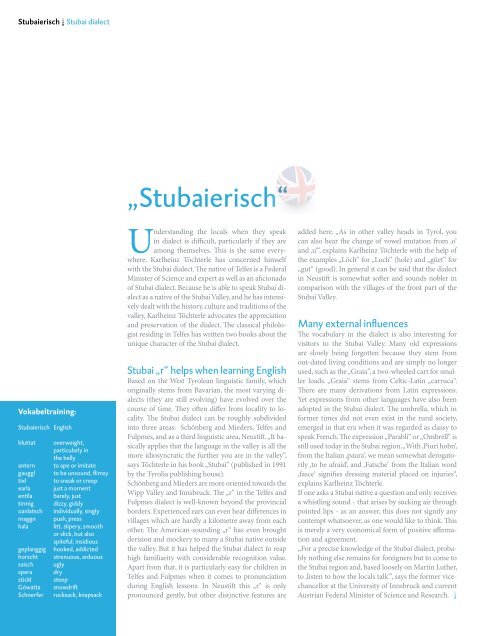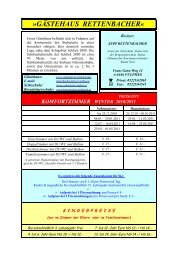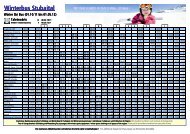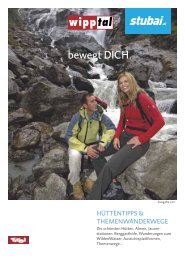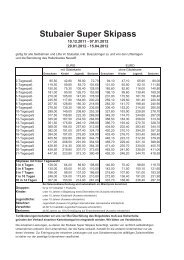Sie wollen auch ein ePaper? Erhöhen Sie die Reichweite Ihrer Titel.
YUMPU macht aus Druck-PDFs automatisch weboptimierte ePaper, die Google liebt.
<strong>Stubai</strong>erisch " <strong>Stubai</strong> dialect<br />
Vokabeltraining:<br />
<strong>Stubai</strong>erisch English<br />
bluttat overweight,<br />
particularly in<br />
the belly<br />
antern to ape or imitate<br />
gauggl to be unsound, flimsy<br />
tixl to sneak or creep<br />
earla just a moment<br />
entila barely, just<br />
tirmig dizzy, giddy<br />
oanlatsch individually, singly<br />
maggn push, press<br />
hala litt. slipery, smooth<br />
or slick, but also<br />
spiteful, insidious<br />
geplanggig hooked, addicted<br />
horscht strenuous, arduous<br />
saisch ugly<br />
spera dry<br />
stickl steep<br />
Gówatta snowdrift<br />
Schnerfer rucksack, knapsack<br />
30<br />
„<strong>Stubai</strong>erisch“<br />
Understanding the locals when they speak<br />
in dialect is difficult, particularly if they are<br />
among themselves. This is the same everywhere.<br />
Karlheinz Töchterle has concerned himself<br />
with the <strong>Stubai</strong> dialect. The native of Telfes is a Federal<br />
Minister of Science and expert as well as an aficionado<br />
of <strong>Stubai</strong> dialect. Because he is able to speak <strong>Stubai</strong> dialect<br />
as a native of the <strong>Stubai</strong> Valley, and he has intensively<br />
dealt with the history, culture and traditions of the<br />
valley, Karlheinz Töchterle advocates the appreciation<br />
and preservation of the dialect. The classical philologist<br />
residing in Telfes has written two books about the<br />
unique character of the <strong>Stubai</strong> dialect.<br />
<strong>Stubai</strong> „r“ helps when learning English<br />
Based on the West Tyrolean linguistic family, which<br />
originally stems from Bavarian, the most varying dialects<br />
(they are still evolving) have evolved over the<br />
course of time. They often differ from locality to locality.<br />
The <strong>Stubai</strong> dialect can be roughly subdivided<br />
into three areas: Schönberg and Mieders, Telfes and<br />
Fulpmes, and as a third linguistic area, Neustift. „It basically<br />
applies that the language in the valley is all the<br />
more idiosyncratic the further you are in the valley“,<br />
says Töchterle in his book „<strong>Stubai</strong>“ (published in 1991<br />
by the Tyrolia publishing house).<br />
Schönberg and Mieders are more oriented towards the<br />
Wipp Valley and Innsbruck. The „r“ in the Telfes and<br />
Fulpmes dialect is well-known beyond the provincial<br />
borders. Experienced ears can even hear differences in<br />
villages which are hardly a kilometre away from each<br />
other. The American-sounding „r“ has even brought<br />
derision and mockery to many a <strong>Stubai</strong> native outside<br />
the valley. But it has helped the <strong>Stubai</strong> dialect to reap<br />
high familiarity with considerable recognition value.<br />
Apart from that, it is particularly easy for children in<br />
Telfes and Fulpmes when it comes to pronunciation<br />
during English lessons. In Neustift this „r“ is only<br />
pronounced gently, but other distinctive features are<br />
added here. „As in other valley heads in Tyrol, you<br />
can also hear the change of vowel mutation from ‚o‘<br />
and ‚u‘“, explains Karlheinz Töchterle with the help of<br />
the examples „Löch“ for „Loch“ (hole) and „güet“ for<br />
„gut“ (good). In general it can be said that the dialect<br />
in Neustift is somewhat softer and sounds nobler in<br />
comparison with the villages of the front part of the<br />
<strong>Stubai</strong> Valley.<br />
Many external influences<br />
The vocabulary in the dialect is also interesting for<br />
visitors to the <strong>Stubai</strong> Valley. Many old expressions<br />
are slowly being forgotten because they stem from<br />
out-dated living conditions and are simply no longer<br />
used, such as the „Graia“, a two-wheeled cart for smaller<br />
loads. „Graia“ stems from Celtic-Latin „carruca“.<br />
There are many derivations from Latin expressions.<br />
Yet expressions from other languages have also been<br />
adopted in the <strong>Stubai</strong> dialect. The umbrella, which in<br />
former times did not even exist in the rural society,<br />
emerged in that era when it was regarded as classy to<br />
speak French. The expression „Parabli“ or „Ombrell“ is<br />
still used today in the <strong>Stubai</strong> region. „With ‚Piuri hobn‘,<br />
from the Italian ‚paura‘, we mean somewhat derogatorily<br />
‚to be afraid‘, and ‚Fatsche‘ from the Italian word<br />
‚fasce‘ signifies dressing material placed on injuries“,<br />
explains Karlheinz Töchterle.<br />
If one asks a <strong>Stubai</strong> native a question and only receives<br />
a whistling sound - that arises by sucking air through<br />
pointed lips - as an answer, this does not signify any<br />
contempt whatsoever, as one would like to think. This<br />
is merely a very economical form of positive affirmation<br />
and agreement.<br />
„For a precise knowledge of the <strong>Stubai</strong> dialect, probably<br />
nothing else remains for foreigners but to come to<br />
the <strong>Stubai</strong> region and, based loosely on Martin Luther,<br />
to ‚listen to how the locals talk‘“, says the former vicechancellor<br />
at the University of Innsbruck and current<br />
Austrian Federal Minister of Science and Research. "


